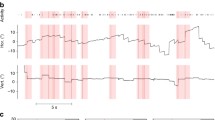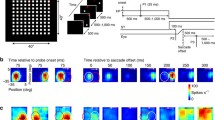Summary
We found in the posterior parietal association cortex (area 7a) of alert monkeys a group of neurons that were specifically sensitive to the rotation of a visual stimulus (N=21). They responded to rotation of a stimulus in a particular direction much better than to the linear movement in any direction, regardless of shape or orientation of the stimulus. Responses were relatively independent of stimulus position within relatively large receptive fields. The majority of these neurons (N=13) responded to rotation in depth either in the saggital, horizontal or diagonal plane rather than in the frontoparallel plane. These neurons were localized in a small region on the anterior bank of the superior temporal sulcus and may be related directly to the perception of rotation of visual objects in space.
Similar content being viewed by others
References
Ames A (1951) Visual perception and the rotating trapezoidal window. Psychol Monogr 65: No. 324
Baker JF, Petersen SE, Newsome WT, Allman JM (1981) Visual response properties of neurons in four extrastiate visual areas of the owl monkey (Aotus trivirgatus): a quantitative comparizon of medial, dorsomedial, dorsolateral, and middle temporal areas. J Neurophysiol 45: 397–416
Börjesson E, Hofsten C von (1975) A vector model for perceived object rotation and translation in space. Psychol Res 38: 209–230
Braunstein ML (1972) Perception of rotation in depth: a process model. Psychol Rev 79: 510–524
Bruce C, Desimone R, Gross CG (1981) Visual properties of neurons in a polysensory area in superior temporal sulcus of the macaque. J Neurophysiol 46: 369–384
Fieandt K von, Moustgaard IK (1977) In: The perceptual world. Academic, London
Gattas R, Gross CG (1981) Visual topography of striate projection zone (MT) in posterior superior temporal sulcus of the macaque. J Neurophysiol 46: 621–638
Jeeves MA, Milner AD, Perrett DI, Smith PAJ (1983) Visual cells responding to direction of movement and stimulus form in the anterior superior temporal sulcus of the macaque monkey. J Physiol (Lond) 341: 80p
Johansson G, Jansson G (1968) Perceived rotary motion from changes in a straight line. Percept Psychophys 4: 165–170
Leinonen L (1980) Functional properties of neurons in the posterior part of area 7 in awake monkey. Acta Physiol Scand 108: 301–308
Maunsell JHR, Van Essen DC (1983a) Functional properties of neurons in middle temporal visual area of the macaque monkey. I. Selectivity for stimulus direction, speed and orientation. J Neurophysiol 49: 1127–1147
Maunsell JHR, Van Essen DC (1983b) The connections of the middle temporal visual area (MT) and their relationship to a cortical hierarchy in the macaque monkey. J Neurosci 3: 2563–2586
Motter BC, Mountcastle VC (1981) The functional properties of the light sensitive neurons of the posterior parietal cortex studied in waking monkeys: foveal sparing and opponent vector organization. J Neurosci 1: 3–26
Rizzolatti G, Scandolara C, Matelli M, Gentilucci M (1981) Afferent properties of periarcuate neurons in macaque monkeys. II. Visual responses. Behav Brain Res 2: 147–163
Robinson DL, Goldberg ME, Stanton GB (1978) Parietal association cortex in the primate: sensory mechanisms and behavioral modulations. J Neurophysiol 41: 910–932
Rubin E (1927) Visuell wahrgenommene wirkliche Bewegungen. Z Psychol 103: 384–392
Sakata H, Shibutani H, Kawano K (1980) Spatial properties of visual fixation neurons in posterior parietal association cortex of the monkey. J Neurophysiol 43: 1654–1672
Sakata H, Shibutani H, Kawano K (1983) Functional properties of visual tracking neurons in posterior parietal association cortex of the monkey. J Neurophysiol 49: 1364–1380
Sakata H, Shibutani H, Ito Y, Tsurugai K (1984) Parietal visual neurons responding to rotary movements of the visual stimulus. J Physiol Soc Jpn 46: 445
Sakata H, Shibutani H, Kawano K, Harrington TL (1985) Neural mechanisms of space vision in the parietal association cortex of the monkey. Vision Res 25: 453–463
Ungerleider LG, Mishkin M (1979) The striate projection zone in the superior temporal sulcus of macaca mulatta: location and topographic organization. J Comp Neurol 188: 347–366
Van Essen DC, Maunsell JHR, Bixby JL (1981) The middle temporal visual area in the macaque: myeloarchitecture, connections functional properties and topographic organization. J Comp Neurol 199: 293–326
Zeki SM (1974a) Functional organization of a visual area in the posterior bank of the superior temporal sulcus of the rhesus monkey. J Physiol (Lond) 236: 549–573
Zeki SM (1974b) Cells responding to changing image size and disparity in the cortex of the rhesus monkey. J Physiol (Lond) 242: 827–841
Author information
Authors and Affiliations
Rights and permissions
About this article
Cite this article
Sakata, H., Shibutani, H., Ito, Y. et al. Parietal cortical neurons responding to rotary movement of visual stimulus in space. Exp Brain Res 61, 658–663 (1986). https://doi.org/10.1007/BF00237594
Received:
Accepted:
Issue Date:
DOI: https://doi.org/10.1007/BF00237594




